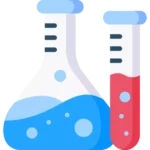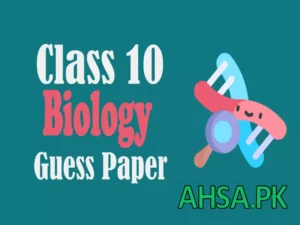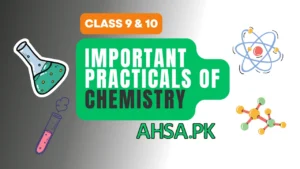Guess Paper Chemistry for Class 10 is up-to-date and the most important questions are given according to Punjab boards. These guess papers will help you get the highest marks on your papers. Punjab Board guess paper Chemistry is relevant to all chapters and we have tried to put all necessary questions that help students to score more than seventy percent.
10th class Chemistry guess paper by Ahsa.Pk is available and you may ask if you need any assistance from our qualified team. Chemistry Matric guess papers are helpful material that may enhance the chances of the students getting more marks in less time.
Guess Paper Chemistry Class 10
Chemistry Class 10 Important Chapter-wise Short Questions
Chapter 9
- What are reversible & irreversible reactions?
- Define the terms Dynamic equilibrium and static equilibrium.
- What is the law of mass action?
- Define equilibrium constant.
- How dynamic equilibrium constant is established?
- Give the relationship between active mass and rate of reaction.
- How direction of a reaction can be predicted?
Chapter 10
- Define Acid & base according to Arrhenius.
- Write limitations of Arrhenius’s concept.
- What is Bronsted Lowry’s Theory?
- Differentiate between Lewis’s acid & base.
- Why does the H+ ion act as a Lewis acid?
- Give four uses of sulphuric acid.
- Define pH. What is the pH of pure water?
- Define the pH of a solution.
- Define indicators.
- What are salts? Give two examples.
- Give four uses of salts.
- Write four uses of sodium silicate, calcium chloride, calcium oxide
- Differentiate between acidic salts & basic salts.
Chapter 11
- Define Vital force theory.
- Define organic compounds.
- Define Catenation.
- Briefly explain molecular formula with an example.
- Write a functional group of alcohol.
- How coal is formed?
- Define functional group.
- What is the dot & cross formula?
- Define open chain/acyclic compound.
- Define alicyclic/non-Benzenoid compounds.
- Define Heterocyclic compounds with an example.
- Define isomerism. How many isomers does pentane have?
Chapter 12
- Define hydrocarbons.
- Define open-chain hydrocarbons & Closed chain hydrocarbons.
- What are Saturated & unsaturated hydrocarbons?
- Why alkanes are called “Paraffin”?
- What is meant by the Hydrogenation of alkenes?
- Give Uses of ethane & ethane.
Chapter 13
- Define Biochemistry.
- Define Polysaccharides & give their properties
- Write the characteristics of monosaccharides.
- Define amino acid. Give its general formula.
- Differentiate between essential & non-essential amino acids.
- Write Sources & uses of vitamin A, Vitamin D.
- Carbohydrates & their uses
- Difference between ghee & oil.
- Give the function of DNA.
- Write types of vitamins.
- How do you justify RNA works like a messenger?
Chapter 14
- Atmosphere & its spheres
- Diff. b/w atmosphere & environment
- Name the major constituents of the troposphere.
- Define pollutants. Differentiate b/w primary & secondary pollutants.
- What is the greenhouse effect?
- Global warming & its effects
- Why CO2 is called greenhouse gas?
- CO2 is responsible for heating up the atmosphere, how?
- Effects of acid rain
- Define the Ozone hole & where was it noticed first.
- Effects of ozone depletion
- Where the ozone layer is found?
- How does acid rain increase the acidity of soil?
- Why CO is considered a health hazard?
- How is Sulphur sulfur-containing compound emitted naturally?
Chapter 15
- How does water rise in plants?
- Write four properties of water
- Define capillary action
- Why the water molecule is polar?
- Soft water & hard water
- How temporary hardness of water can be removed by Clark’s method?
- Define boiler scales. How are they removed?
- Why are pesticides & fertilizers used?
- Why non-polar compounds are insoluble in water?
- How does water rise in plants?
- Disadvantages of detergents.
- Name some waterborne diseases.
- Define Fluorosis.
Chapter 16
- Define metallurgy.
- Difference b/w Minerals & Ores.
- State gravity separation.
- What is Electromagnetic separation?
- Define Roasting. How is it carried out?
- What are the raw materials of Solvay’s process?
- Give advantages of Solvay’s process.
- Define Petroleum.
- Write formation of petroleum.
- How roasting is carried out?
- Difference between crude oil & residual oil.
- Difference between diesel oil & fuel oil.
- Which raw materials are used in the manufacturing of urea?
- How NaHCO3 is converted into Na2CO3?
Biology Class 10 Important Chapter-wise Long Questions
Chapter 9
- What is meant by a complete & incomplete reaction? Why reactions do not go to completion?
- Give the macroscopic characteristics of forward reactions, reverse reactions & dynamic equilibrium.
- State the law of mass action and derive the expression for the equilibrium constant for a given reaction A +B>< C+D / general reaction.
- Explain the importance of the equilibrium constant.
- Describe a reversible reaction with the help of an example & graph.
Chapter 10
- Compare the physical properties of acids & bases with examples.
- Explain the Arrhenius concept of acids & bases with examples. What are the limitations of this concept?
- Explain Lewis’s concept of an acid & a base.
- What are indicators? How they are used to determine the pH of acidic, basic, and neutral solutions.
- Define salts. Explain the characteristics and uses of some important salts.
- Give the application/uses of some important bases.
- Explain Bronsted Lowry’s concept of an acid and base with examples.
Chapter 11
- Write a note on the classification of organic compounds.
- Compare the general characteristics of organic & inorganic compounds.
- Define homologous series. Write its characteristics.
- Define functional group. Explain the functional group of alcohols, ethers, aldehydes, ketones, carboxylic acid, esters, etc.
- Explain the meaning of molecular formula, structural formula, condensed structural formula & electronic formula.
Chapter 12
- Define hydrocarbons. How are they classified?
- Explain methods for the preparation of alkanes & alkenes.
- Discuss the physical properties of alkenes & alkynes.
- Write uses of ethane, ethane, methane & acetylene.
- Give chemical reactions of alkanes.
Chapter 13
- Define monosaccharides & oligosaccharides. Give their characteristics.
- Give uses and sources of carbohydrates.
- Define amino acid. Explain how are they building blocks of proteins.
- Explain the sources & uses of proteins & lipids.
- Define vitamins. Discuss the types, sources used & importance of vitamins. Also, write the effects of deficiency of vitamins.
- What are carbohydrates? How monosaccharides are prepared?
Chapter 15
- What are the causes of hardness in water and methods to remove hardness?
- Explain industrial effluents and their effects.
- Give the effects of water pollution.
- Write a note on waterborne diseases.
Chapter 16
- Write a detailed note on electromagnetic separation (Smelting, Bessemerization).
- Describe the manufacture of sodium carbonate by Solvay’s process (reactions, advantages).
- Explain the process of manufacturing Urea (3 basic steps).











